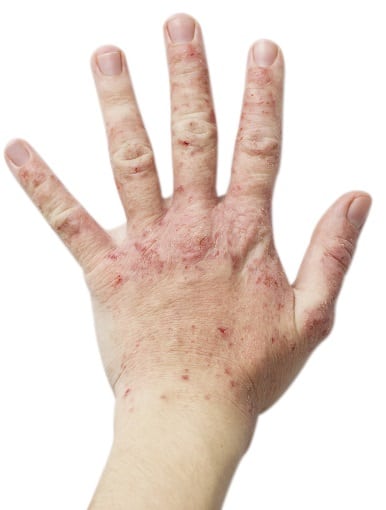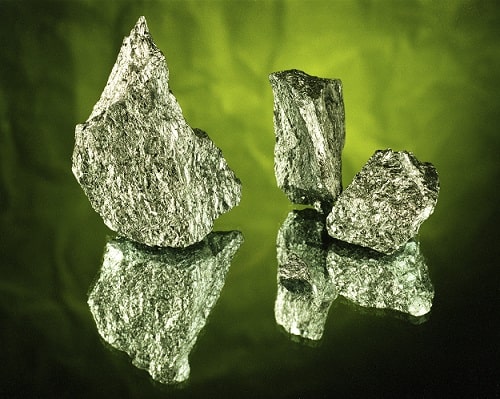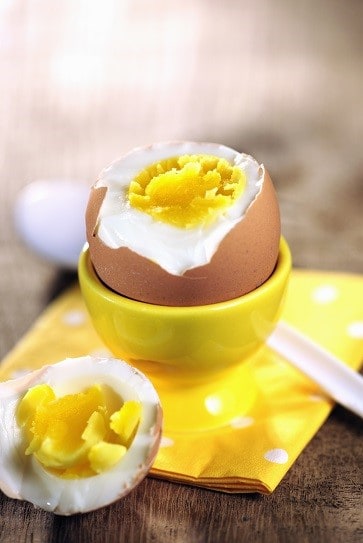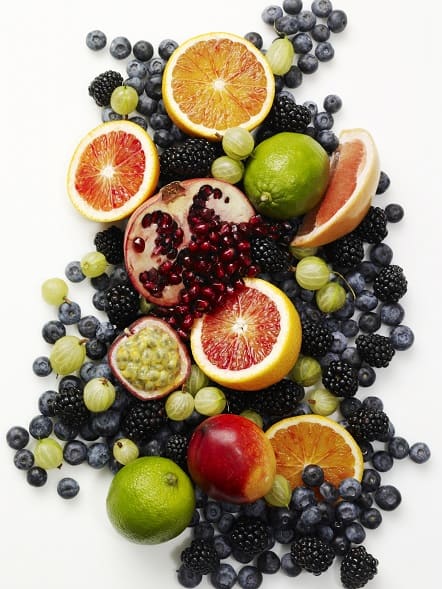 There’s massive confusion about the real causes of acne in teenagers, and one area where confusion truly reigns supreme is in blocked pores.
There’s massive confusion about the real causes of acne in teenagers, and one area where confusion truly reigns supreme is in blocked pores.
Conventional wisdom states that oily skin is the sole villain. It’s easy to make assumptions; your raging hormones first give you acne during puberty, and that’s when your face becomes like a BP oil spill too.
High sebum production is certainly important, clogging your pores, helping p.acnes bacteria to overgrow, and unleashing inflammation. Oily skin strategies like getting more vitamin A, increasing vitamin D or exercising more are undoubtedly excellent for acne patients.
But there’s one overlooked player which is just as important: keratin, a protein that blocks pores by binding dead skin cells together.
A dodgy diet is by far the biggest cause of acne (about ten times more important than poor hygiene), and keratin is one reason why.
What is keratin?
Keratin is a fibrous family of proteins. As cells called keratinocytes, it’s the main protein in the epidermis, the outer layer of human skin. Keratin has many other roles in the body; for example, it strengthens organs like the tongue.
Human nails, meanwhile, consist of 77% keratin, 18% water, and 5% oils. Nails contain 100 layers of super compressed, densely packed keratin. Human toenails contain 150 layers.
Read Annihilate Your Acne – get the ultimate diet for clear and glowing skin!
Hair contains even more, boasting 80-90% keratin, 1% pigments and oils, and 9-19% water, but sometimes up to 95% keratin depending on the hair’s dryness. Over in the animal kingdom, dog claws and horse hooves are nearly entirely keratin.
Basically, keratin is an unbeatable binding and adhesive protein, gluing cellular structures together with no remorse. Alongside chitin, keratin is the strongest tissue found in nature. Keep that strength and stickiness in mind for later.
Normally, humanity lives in perfect peace with keratin. It’s vital for health, mainly because without it, your organs and skin would fall apart like Lego. But there’s one nasty condition known as hyperkeratosis, where the body’s keratin regulation fails, sending it into overdrive.
The immediate symptom is an abnormal thickening of the skin’s outer layer. However, hyperkeratosis can also lead to eczema, and palmar and plantar keratosis. That’s a congenital, often hereditary, thickening of the horny layer of the palms and soles, sometimes with painful lesions resulting from fissures.
In rural villages of Bangladesh, contaminated water has led to an epidemic of arsenic keratoses, unsightly dark protein growths which often progress to cancer. Keratin overgrowth causes many other skin conditions too, and that’s why your body keeps its production on an extremely tight leash.
How keratin causes acne
You might have guessed that one of those “other skin conditions” is acne. Human skin cells are constantly dying and regenerating. The dead ones float away into household dust, but first, they separate and fall into your hair follicle.
Important article – the top 6 vitamins and minerals for clearing acne
Normally, the gradual growth of hair pushes dead skin cells out of the follicle and onto the skin’s surface. From there, they are simply washed away by sweat or water…
…but during hyperkeratosis this grinds to a halt. Instead, keratin prevents the dead skin cells from separating. It glues them together into large clumps, which remain in your hair follicle. It is here that keratin kicks off the entire pore-blocking process.
The dead cell clumps trap sebum (oil) within the pore, which acne patients typically have gallons of. The oil builds up and up, more dead skin cells are trapped, and you now have a comedone AKA a blocked pore.
From there, acne kicks off in the way we regularly discuss. P.acnes bacteria has a low oxygen environment to multiply in, this overgrowth stimulates an immune system response, and that response inflames and swells the clogged pore. Acne is born. It can be a pimple, a whitehead, a pustule, or any type, because keratin simply acts through blocking skin pores.
Excessive keratin is just as important as oily skin for constantly clogged pores.
In fact, dead skin cell overgrowths create the very first acne lesions, called microcomedones. They only progress to fully fledged open comedones (blackhead) or closed comedones (whitehead) later, when sebum appears.
Why bread and pasta are a massive cause of acne
It’s easy to see your face looking an in-use frying pan and instantly blame oily skin for acne, but you should NEVER ignore keratin. It could be the missing link if lowering sebum production hasn’t yielded results yet.
Your job is to avoid massive keratin overproduction, not to crush it. Some other signs of hyperkeratosis include…
- A thick and tough outer layer of skin.
- Dark coloured growths of protein.
- Corns, calluses, warts and eczema.
- Seborrheic keratoses. Small, noncancerous skin growths. Can be tan, brown or black.
- Actinic keratoses. Flat, rough, red, sandpaper-like spots or patches of skin. Can be as tiny as a few millimetres.
Look at your hands and arms rights now. If you’ve got the signs and symptoms, then reducing keratin is critical.
Hyperkeratosis is surprisingly common; consider hyperkeratosis pilaris, characterised by hard protein masses and bumps with a yellowish tinge on the skin’s surface. This disease affects 40% of adults and a massive 60-70% of adolescents.
Unlike my other recommended strategies like increasing magnesium, vitamin D, etc., reducing keratin is widely recognised by mainstream dermatologists. Salicylic acid is found in countless facial cleansers, targeted pimple soothers, and face washes, and it works through keratolytic properties: breaking apart the keratin bond between dead skin cells.
Important article – the top 6 vitamins and minerals for clearing acne
Apple cider vinegar is another topical treatment with keratolytic properties. Accutane succeeds (with side effects) partly because it’s a hyper concentrated form of vitamin A, which combats hyperkeratinisation.
So how do you control keratin production?
 This is where Supernatural Acne Treatment and mainstream dermatology disagree. It’s totally unnecessary to blast your face with chemical cleansers or risk depression, inflammatory bowel disease, and hair loss with Accutane.
This is where Supernatural Acne Treatment and mainstream dermatology disagree. It’s totally unnecessary to blast your face with chemical cleansers or risk depression, inflammatory bowel disease, and hair loss with Accutane.
In a healthy human, keratin is tightly regulated. Hyperkeratosis is only an epidemic because of the lunatic modern diet which is totally lacking nutrients like zinc, and because of common environmental toxins like arsenic. Every human being alive has the power to constrain keratin:
Vitamin A – by far the most verified tactic. It’s an accepted medicinal fact that vitamin A downregulates keratin and the turnover of dead skin cells. Again, that’s the secret behind Accutane, and also topical retinoids like retinoid acid, which act directly on keratin producing cells (keratinocytes).
Its exact powers against keratin remain mysterious. However, vitamin A affects the proliferation of numerous cell types, which it achieves by binding to retinoid receptors, some of which inhibit keratin production directly.
Read the eBook: learn why common vegetable oils are an acne nightmare
Vitamin A, or retinol, is also an antagonist of Activating Protein 1 (AP-1), a well-established regulator of keratinocyte production (study). It isn’t completely simple, as vitamin A can actually increase many keratin types, like K4, K6, K13, K16, K17 and K19. But overall, vitamin A has a strong controlling effect.
Zinc – a mineral with a simple benefit: zinc helps to manufacture retinol binding protein. All vitamin A in the skin must be transported through the blood by retinol binding protein first. Hence, zinc enhances its keratin-controlling powers, and therefore works largely indirectly. Zinc is critical for controlling the immune system as well, and in this study, 54.1% of acne patients were deficient.
As far as I’m concerned, the greatest zinc supplement yet invented by mankind is this MegaFood Zinc (amazon link).
All acne-clearing requirements are catered for; the zinc is food-based and well absorbed, there are no inflammatory additives, it’s still reasonably cheap, and there’s even a bonus fruit and vegetable blend. A cheaper, but still pure and well-absorbed brand is this Thorne Research Zinc Picolinate (amazon link).
 Vitamin E – this is where we wade into acne waters rarely travelled. A massive proportion of keratin overexpression is actually caused by a little known condition called sebum oxidation. Basically, it’s when squalene, a fatty acid forming 12% of sebum (oil), is exposed to free radicals and oxidises. This creates a by-product called squalene peroxide, the most comedogenic (pore-clogging) substance on earth.
Vitamin E – this is where we wade into acne waters rarely travelled. A massive proportion of keratin overexpression is actually caused by a little known condition called sebum oxidation. Basically, it’s when squalene, a fatty acid forming 12% of sebum (oil), is exposed to free radicals and oxidises. This creates a by-product called squalene peroxide, the most comedogenic (pore-clogging) substance on earth.
In one study, scientists could induce acne simply by applying squalene peroxide to a rabbit’s ear. Importantly, its main pore-clogging ability is stimulating keratin production massively.
This study found that squalene peroxide caused both inflammation and hyperkeratinisation. In this interesting review of hyperkeratosis and acne, scientists commented that “lipoperoxides… are capable of inducing alteration in keratinocyte proliferation and differentiation”.
Squalene oxidation might be the most overlooked cause of keratin mayhem. Preventing it is a top priority, and the solution is vitamin E.
Raw honey – a natural secret for wiping out acne bacteria
Your sebaceous glands gift all new sebum created with vitamin E, the body’s main fat soluble antioxidant, to protect it from oxidation. Unfortunately though, vitamin E deficiency is rampant in acne patients. You too almost certainly need more.
Therefore, you have two options: 1) use this article to arrange a diet packed with the richest food sources. Or 2) eat good amounts of vitamin E through your diet, and top it off with a natural supplement, such as my favourite, the natural, plant-derived Garden of Life Raw Vitamin E (amazon link).
Antioxidants – vitamin E is the most abundant antioxidant in sebum, but other dietary antioxidants, especially fat soluble antioxidants (since sebum is a lipid) can also prevent squalene oxidation.
One example is lycopene, the famously healthy tomato antioxidant which gives them their red colour and may protect the heart. Lycopene accumulates directly in your skin cells; one healthy consequence is protection from UV rays.
Lycopene specialises in protecting lipids (like cholesterol molecules) and sebum is also a lipid. The famous resveratrol from red wine also builds up in skin cells, as do the cocoa polyphenols in chocolate. Furthermore, any antioxidant that hoovers up free radicals across the whole body will leave more room for vitamin E (and lycopene) to focus on the skin, and protecting sebum. The opportunities are wide.
 Glutathione – humans manufacture some antioxidants on their own, and glutathione is the main one. This study found a 20% deficiency rate in acne patients, so increasing your levels by eating Brazil nuts or taking magnesium is smart. Glutathione does not appear in sebum itself (scientists believe), but it does appear in the skin, and scavenges the free radicals which later attack sebum.
Glutathione – humans manufacture some antioxidants on their own, and glutathione is the main one. This study found a 20% deficiency rate in acne patients, so increasing your levels by eating Brazil nuts or taking magnesium is smart. Glutathione does not appear in sebum itself (scientists believe), but it does appear in the skin, and scavenges the free radicals which later attack sebum.
Zinc will help again, as it’s one of the main co-factors in glutathione production. An excellent magnesium supplement is this Pure Encapsulations Magnesium Glycinate (amazon link), while the best source of concentrated selenium is eating two of these Terrasoul Superfoods Raw Brazil Nuts (amazon link) daily. A pure and potent selenium pill is this Pure Encapsulations Selenium (amazon link).
Why vitamin C is the acne nutrient you cannot ignore
Air pollution – the ozone found in city air is not a free radical itself, but generates tons when it reacts with your skin. Hence, air pollution is potent at causing squalene oxidation and higher keratin output. These free radicals are partly behind the grey and lifeless skin of city dwellers, with premature winkles and no radiant glow.
Cigarette smoke – tobacco is a weak plant that is highly prone to oxidation. With a single puff on a cigarette, you will ingest an estimated one trillion free radicals, draining your vitamin E and other precious antioxidants. Furthermore, simply bathing your face in all that smoke wafting around can oxidise your sebum directly. E-cigarettes contain free radicals, but are superior to normal ones.
Arsenic – a heavy metal which is notorious for hyperkeratosis.
For example, drinking water from deep underground wells is notoriously arsenic contaminated, since arsenic is a metal in the earth’s crust. There’s been big charity projects in Bangladesh to build deep wells, to protect children from dirty monsoon water with parasites, but there’s also been a side effect. Arsenic poisoning, and its own side effect has been arsenical keratoses, the unsightly growths of protein we discussed earlier.
It’s so bad now that doctors visiting Bangladeshi villages instantly examine their skin to identify cases of arsenic poisoning. The only mystery is precisely how arsenic increases keratin. Arsenic is a toxic heavy metal, so avoid it all you can. Find out how in this article.
Zinc and vitamin A are your top priorities, being instantly fixable, particularly the latter. Because our gut bacteria is so compromised, our ability to convert plant-based vitamin A (beta-carotene) into the active retinol form is seriously impaired.
Avoiding arsenic from rice, fruit juice and drinking water is also a must. It causes cancer and brain damage anyway! Also, if arsenic has this power, then it’s surely inevitable that a handful of other chemicals and heavy metals will.
There’s little research into pesticides and keratin, for example, so it’s prudent to lead a clean lifestyle with organic foods and natural cosmetics where you can. In fact, hidden environmental toxins are a huge cause of acne full-stop, and a little known one. We discuss this in depth in my eBook.
Conclusion
Keratin is a pivotal player in clogged skin pores, and consequently, it has big potential for almost all acne patients. If you’ve only focussed on oil in the past, then a whole new avenue of opportunity has opened up.
Like usual, it might take a few weeks for acne to fall, since the dead skin cells won’t degrade and be pushed out instantaneously.
Also remember that blocked pores are only one factor behind acne. It’s chronic inflammation which kickstarts the entire chain reaction of acne. Keratin and blocked pores only set the stage. Anti-inflammatory strategies like green vegetables and avoiding sugar are also significantly quicker.
By combining a reduction in keratin, sebum production, and chronic inflammation, and also getting more antioxidants and banishing free radicals, your acne will be doomed.
NEXT: learn the root causes of acne, clear your skin permanently
Thanks for reading!